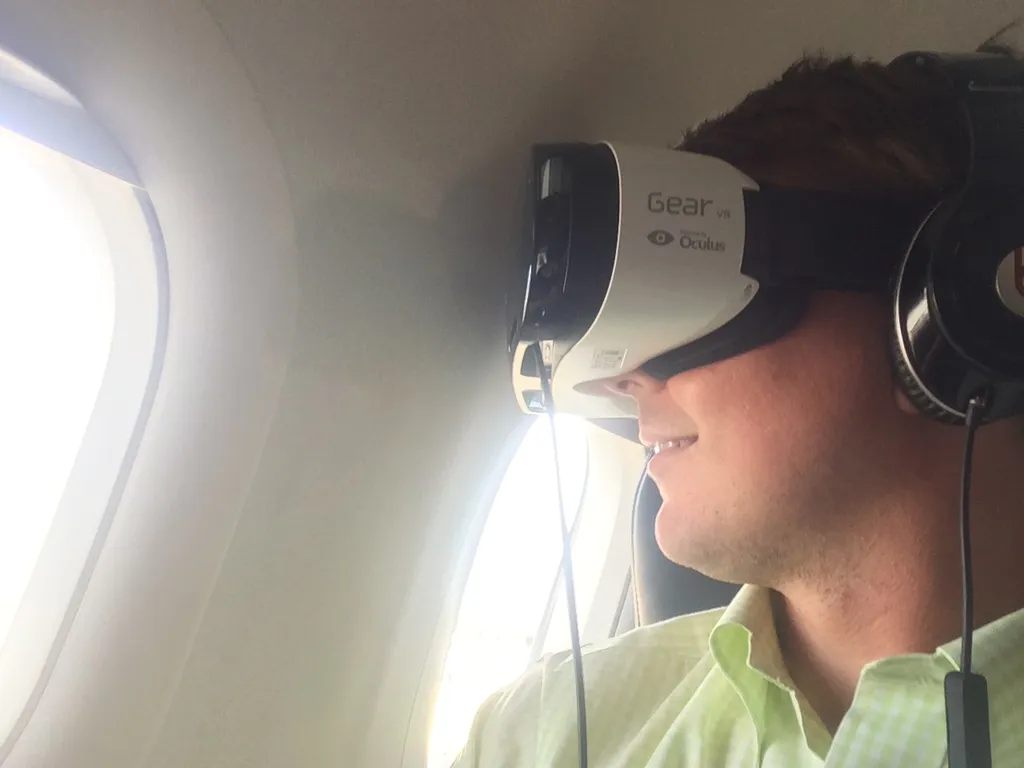I squeezed down the aisle, making my way to my seat. It was a crazily full flight, and any hope of an empty middle seat had long since faded. I crossed my fingers as I approached, hoping for a quiet set of neighbors… funny thing about hope. I reached my seat and my face sunk, in the section were not one, but two babies and my middle seat neighbor was about to spend the flight stress testing his seatbelt. Thank goodness for VR and noise cancelling headphones.
Settling in, I busted out the GearVR and tossed it on, hopping right into Oculus Cinema to binge watch some movies I hadn’t gotten around to. I spent about four and a half hours consecutively in the Cinema, taking off the headset only once during that period. This actually wasn’t my first time trying VR on an airplane, but it was my first using the GearVR on one – and doing so revealed a couple of things to me that I think need to be worked on – namely, GearVR needs a ‘movement mode.’
I would say that airplanes and public transport systems will be among the top use environments for mobile VR. In fact, earlier this year the Australian airline Qantas struck a partnership with Samsung to bring the GearVR to the first class cabins of their planes. Those passengers, however, might be spending a lot of time interrupting their films to reset the orientation (and forget about looking around in full 360).
When I was in flight I had to reset the orientation about once every 10 minutes. Even though the plane was (as far as I could perceive) flying in a straight line, the cinema screen slowly would drift from right to left, slow enough that I instinctively would follow it until I realized that I was staring right at the guy next to me (and likely thoroughly creeping him out in the process). I believe this gradual drift was due to the curvature of the Earth (which is pretty cool) as I was traveling from the East coast to the West. The constant drifting movement was also somewhat hard on my neck after a few hours and for the passengers on Qantas and airlines of the future, that’s not going to fly (sorry).
This problem seems like a solvable one. The addition of an ‘airplane/movement mode’ that would detect and help correct for constant, smooth motion – like that on an airplane – would likely help to alleviate the issue. Obviously, restricting movement detection is something you wouldn’t always want to do, but having the ability to turn it on and off would make the GearVR much more usable while in motion. But that wouldn’t be all this would need to enable. When you are traveling you are often confined to a fixed seat which restricts one’s ability to turn in full 360. Were there to be something similar to World War Toon‘s ‘quick turn’ system -which allows for full 360 turning with smaller movements – that might help to solve the issue.
Despite the minor issues, overall it really made for a pleasant flight. Gone were the crying babies and man spilling into my personal space, in their stead was a peaceful moon scene (btw, one minor gripe – love the light effects on the ground, but they really shouldn’t be spilling into the sky so much). The expansive environment allowed me to momentarily forget I was on a plane and even tricked my mind into feeling like I had enough legroom. GearVR, despite it’s need for the aforementioned ‘movement mode,’ is an awesome piece of tech that really helped to enable a comfortable and peaceful flight in the midst of chaos around me. Once they have the drifting ironed out, the GearVR will become the choice for quality in-flight entertainment.






























